
Illustrative Math Alignment: Grade 6 Unit 7
Rational Numbers
Lesson 1: Positive and Negative Numbers
Use the following Media4Math resources with this Illustrative Math lesson.
| Thumbnail Image | Title | Body | Curriculum Nodes |
|---|---|---|---|
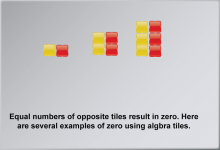
|
Math Clip Art--Number Systems--Integers 10 | Math Clip Art--Number Systems--Integers 10
This is part of a collection of math clip art images about different number systems. Included are integers, rational numbers, and real numbers. |
Numerical Expressions |
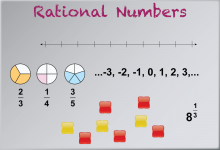
|
Math Clip Art--Number Systems--Rational Numbers 01 | Math Clip Art--Number Systems--Rational Numbers 01
This is part of a collection of math clip art images about different number systems. Included are integers, rational numbers, and real numbers. |
Numerical Expressions |
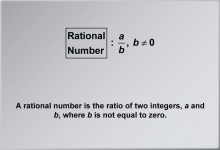
|
Math Clip Art--Number Systems--Rational Numbers 02 | Math Clip Art--Number Systems--Rational Numbers 02
This is part of a collection of math clip art images about different number systems. Included are integers, rational numbers, and real numbers. |
Numerical Expressions |
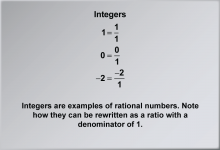
|
Math Clip Art--Number Systems--Rational Numbers 03 | Math Clip Art--Number Systems--Rational Numbers 03
This is part of a collection of math clip art images about different number systems. Included are integers, rational numbers, and real numbers. |
Numerical Expressions |
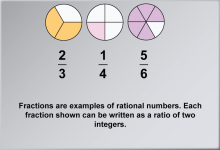
|
Math Clip Art--Number Systems--Rational Numbers 04 | Math Clip Art--Number Systems--Rational Numbers 04
This is part of a collection of math clip art images about different number systems. Included are integers, rational numbers, and real numbers. |
Numerical Expressions |
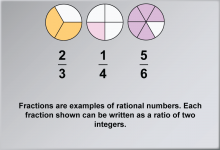
|
Math Clip Art--Number Systems--Rational Numbers 05 | Math Clip Art--Number Systems--Rational Numbers 05
This is part of a collection of math clip art images about different number systems. Included are integers, rational numbers, and real numbers. |
Numerical Expressions |
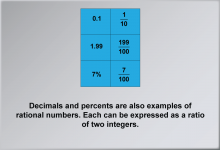
|
Math Clip Art--Number Systems--Rational Numbers 06 | Math Clip Art--Number Systems--Rational Numbers 06
This is part of a collection of math clip art images about different number systems. Included are integers, rational numbers, and real numbers. |
Numerical Expressions |
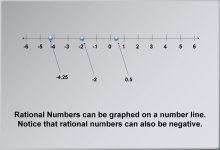
|
Math Clip Art--Number Systems--Rational Numbers 07 | Math Clip Art--Number Systems--Rational Numbers 07
This is part of a collection of math clip art images about different number systems. Included are integers, rational numbers, and real numbers. |
Numerical Expressions |
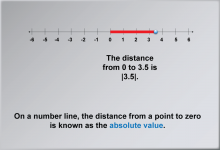
|
Math Clip Art--Number Systems--Rational Numbers 08 | Math Clip Art--Number Systems--Rational Numbers 08
This is part of a collection of math clip art images about different number systems. Included are integers, rational numbers, and real numbers. |
Numerical Expressions |

|
Math Clip Art--Number Systems--Rational Numbers 09 | Math Clip Art--Number Systems--Rational Numbers 09
This is part of a collection of math clip art images about different number systems. Included are integers, rational numbers, and real numbers. |
Numerical Expressions |
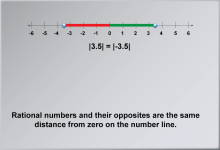
|
Math Clip Art--Number Systems--Rational Numbers 10 | Math Clip Art--Number Systems--Rational Numbers 10
This is part of a collection of math clip art images about different number systems. Included are integers, rational numbers, and real numbers. |
Numerical Expressions |
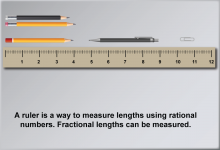
|
Math Clip Art--Number Systems--Rational Numbers 11 | Math Clip Art--Number Systems--Rational Numbers 11
This is part of a collection of math clip art images about different number systems. Included are integers, rational numbers, and real numbers. |
Numerical Expressions |
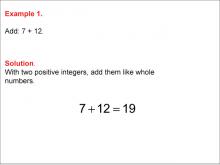
|
Math Example--Arithmetic--Adding Two Integers: Example 1 | Math Example--Arithmetic--Adding Two Integers: Example 1TopicIntegers DescriptionThis example demonstrates the addition of two positive integers: 7 + 12. The solution is straightforward, as it involves adding two whole numbers. When dealing with positive integers, the addition process is similar to that of whole numbers. In this case, 7 + 12 equals 19. |
Numerical Expressions |
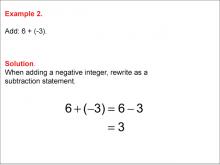
|
Math Example--Arithmetic--Adding Two Integers: Example 2 | Math Example--Arithmetic--Adding Two Integers: Example 2TopicIntegers DescriptionThis example illustrates the addition of a positive and a negative integer: 6 + (-3). When adding a negative integer, it's helpful to rewrite the expression as subtraction. In this case, 6 + (-3) can be rewritten as 6 - 3, which equals 3. This method simplifies the process and helps students understand the relationship between addition and subtraction of integers. |
Numerical Expressions |

|
Math Example--Arithmetic--Adding Two Integers: Example 3 | Math Example--Arithmetic--Adding Two Integers: Example 3TopicIntegers DescriptionThis example demonstrates the addition of a positive and a negative integer: 5 + (-8). When adding a negative integer, it's beneficial to rewrite the expression as subtraction. In this case, 5 + (-8) can be rewritten as 5 - 8, which equals -3. This method helps students understand that adding a negative number is equivalent to subtracting its positive counterpart. |
Numerical Expressions |

|
Math Example--Arithmetic--Adding Two Integers: Example 4 | Math Example--Arithmetic--Adding Two Integers: Example 4TopicIntegers DescriptionThis example showcases the addition of a positive integer and its negative counterpart: 7 + (-7). When adding a negative integer, it's helpful to rewrite the expression as subtraction. In this case, 7 + (-7) can be rewritten as 7 - 7, which equals 0. This example illustrates an important concept in integer addition: any number added to its opposite results in zero. |
Numerical Expressions |
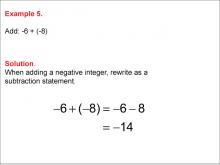
|
Math Example--Arithmetic--Adding Two Integers: Example 5 | Math Example--Arithmetic--Adding Two Integers: Example 5TopicIntegers DescriptionThis example demonstrates the addition of two negative integers: -6 + (-8). When adding negative integers, it's helpful to rewrite the expression as a subtraction statement. In this case, -6 + (-8) can be rewritten as -6 - 8, which equals -14. This method helps students understand that adding two negative numbers results in a number that is more negative than either of the original numbers. |
Numerical Expressions |
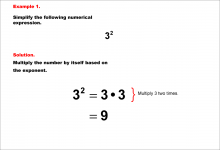
|
Math Example--Exponential Concepts--Integer and Rational Exponents--Example 1 | Math Example--Exponential Concepts--Integer and Rational Exponents--Example 1TopicExponents DescriptionShows Example 1 with the expression 32. The solution explains how to simplify by multiplying 3 by itself according to the exponent. Example 1: Simplify 32. Multiply 3 by itself two times: 3•3 = 9. |
Numerical Expressions |

|
Math Example--Exponential Concepts--Integer and Rational Exponents--Example 1 | Math Example--Exponential Concepts--Integer and Rational Exponents--Example 1TopicExponents DescriptionShows Example 1 with the expression 32. The solution explains how to simplify by multiplying 3 by itself according to the exponent. Example 1: Simplify 32. Multiply 3 by itself two times: 3•3 = 9. |
Numerical Expressions |
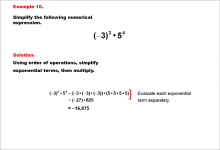
|
Math Example--Exponential Concepts--Integer and Rational Exponents--Example 10 | Math Example--Exponential Concepts--Integer and Rational Exponents--Example 10TopicExponents DescriptionShows Example 10 with the expression (-3)3•54. The solution uses order of operations to evaluate each term before multiplying. Example 10: Simplify (-3)3•54. Evaluate each exponential term separately, then multiply: -27•625= -16,875. |
Numerical Expressions |

|
Math Example--Exponential Concepts--Integer and Rational Exponents--Example 10 | Math Example--Exponential Concepts--Integer and Rational Exponents--Example 10TopicExponents DescriptionShows Example 10 with the expression (-3)3•54. The solution uses order of operations to evaluate each term before multiplying. Example 10: Simplify (-3)3•54. Evaluate each exponential term separately, then multiply: -27•625= -16,875. |
Numerical Expressions |
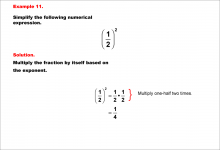
|
Math Example--Exponential Concepts--Integer and Rational Exponents--Example 11 | Math Example--Exponential Concepts--Integer and Rational Exponents--Example 11TopicExponents DescriptionExample 11 shows how to simplify (1/2)2. The image illustrates multiplying 1/2 by itself due to the exponent of 2. Example 11: Simplify (1/2)2. Multiply one-half two times. Solution: (1/2) * (1/2) = 1/4. |
Numerical Expressions |

|
Math Example--Exponential Concepts--Integer and Rational Exponents--Example 11 | Math Example--Exponential Concepts--Integer and Rational Exponents--Example 11TopicExponents DescriptionExample 11 shows how to simplify (1/2)2. The image illustrates multiplying 1/2 by itself due to the exponent of 2. Example 11: Simplify (1/2)2. Multiply one-half two times. Solution: (1/2) * (1/2) = 1/4. |
Numerical Expressions |
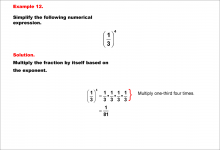
|
Math Example--Exponential Concepts--Integer and Rational Exponents--Example 12 | Math Example--Exponential Concepts--Integer and Rational Exponents--Example 12TopicExponents DescriptionExample 12 shows how to simplify (1/3)4. The image illustrates multiplying 1/3 four times due to the exponent of 4. Example 12: Simplify (1/3)4. Multiply one-third four times. Solution: (1/3) * (1/3) * (1/3) * (1/3) = 1/81. |
Numerical Expressions |

|
Math Example--Exponential Concepts--Integer and Rational Exponents--Example 12 | Math Example--Exponential Concepts--Integer and Rational Exponents--Example 12TopicExponents DescriptionExample 12 shows how to simplify (1/3)4. The image illustrates multiplying 1/3 four times due to the exponent of 4. Example 12: Simplify (1/3)4. Multiply one-third four times. Solution: (1/3) * (1/3) * (1/3) * (1/3) = 1/81. |
Numerical Expressions |
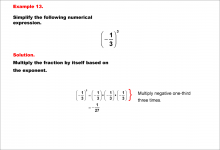
|
Math Example--Exponential Concepts--Integer and Rational Exponents--Example 13 | Math Example--Exponential Concepts--Integer and Rational Exponents--Example 13TopicExponents DescriptionExample 13 shows how to simplify (-1/3)3. The image illustrates multiplying -1/3 three times due to the exponent of 3. Example 13: Simplify (-1/3)3. Multiply negative one-third three times. Solution: (-1/3) * (-1/3) * (-1/3) = -1/27. |
Numerical Expressions |

|
Math Example--Exponential Concepts--Integer and Rational Exponents--Example 13 | Math Example--Exponential Concepts--Integer and Rational Exponents--Example 13TopicExponents DescriptionExample 13 shows how to simplify (-1/3)3. The image illustrates multiplying -1/3 three times due to the exponent of 3. Example 13: Simplify (-1/3)3. Multiply negative one-third three times. Solution: (-1/3) * (-1/3) * (-1/3) = -1/27. |
Numerical Expressions |

|
Math Example--Exponential Concepts--Integer and Rational Exponents--Example 14 | Math Example--Exponential Concepts--Integer and Rational Exponents--Example 14TopicExponents DescriptionExample 14 shows how to simplify 2-1. The image illustrates rewriting 2-1 as the reciprocal of 2 raised to the first power. Example 14: Simplify 2-1. Negative exponents are written as reciprocals. Solution: 2-1 = 1/2. |
Numerical Expressions |

|
Math Example--Exponential Concepts--Integer and Rational Exponents--Example 14 | Math Example--Exponential Concepts--Integer and Rational Exponents--Example 14TopicExponents DescriptionExample 14 shows how to simplify 2-1. The image illustrates rewriting 2-1 as the reciprocal of 2 raised to the first power. Example 14: Simplify 2-1. Negative exponents are written as reciprocals. Solution: 2-1 = 1/2. |
Numerical Expressions |
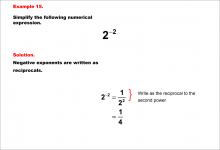
|
Math Example--Exponential Concepts--Integer and Rational Exponents--Example 15 | Math Example--Exponential Concepts--Integer and Rational Exponents--Example 15TopicExponents DescriptionExample 15 shows how to simplify 2-2. The image illustrates rewriting 2-2 as the reciprocal of 2 raised to the second power. Example 15: Simplify 2-2. Negative exponents are written as reciprocals. Solution: 2-2 = 1/(22) = 1/4. |
Numerical Expressions |

|
Math Example--Exponential Concepts--Integer and Rational Exponents--Example 15 | Math Example--Exponential Concepts--Integer and Rational Exponents--Example 15TopicExponents DescriptionExample 15 shows how to simplify 2-2. The image illustrates rewriting 2-2 as the reciprocal of 2 raised to the second power. Example 15: Simplify 2-2. Negative exponents are written as reciprocals. Solution: 2-2 = 1/(22) = 1/4. |
Numerical Expressions |
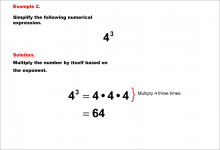
|
Math Example--Exponential Concepts--Integer and Rational Exponents--Example 2 | Math Example--Exponential Concepts--Integer and Rational Exponents--Example 2TopicExponents DescriptionShows Example 2 with the expression 43. The solution explains the simplification by multiplying 4 three times. Example 2: Simplify 43. Multiply 4 by itself three times: 4•4•4 = 64. In general, the topic of exponents involves understanding how repeated multiplication can be expressed more compactly. The examples provided in this collection allow students to see the step-by-step breakdown of how to simplify various exponential expressions, which can include positive and negative bases, fractional bases, and negative exponents. |
Numerical Expressions |

|
Math Example--Exponential Concepts--Integer and Rational Exponents--Example 2 | Math Example--Exponential Concepts--Integer and Rational Exponents--Example 2TopicExponents DescriptionShows Example 2 with the expression 43. The solution explains the simplification by multiplying 4 three times. Example 2: Simplify 43. Multiply 4 by itself three times: 4•4•4 = 64. In general, the topic of exponents involves understanding how repeated multiplication can be expressed more compactly. The examples provided in this collection allow students to see the step-by-step breakdown of how to simplify various exponential expressions, which can include positive and negative bases, fractional bases, and negative exponents. |
Numerical Expressions |
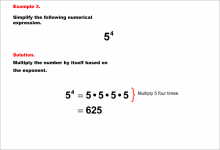
|
Math Example--Exponential Concepts--Integer and Rational Exponents--Example 3 | Math Example--Exponential Concepts--Integer and Rational Exponents--Example 3TopicExponents DescriptionShows Example 3 with the expression 54. The solution details multiplying 5 four times. Example 3: Simplify 54. Multiply 5 by itself four times: 5•5•5•5 = 625. In general, the topic of exponents involves understanding how repeated multiplication can be expressed more compactly. The examples provided in this collection allow students to see the step-by-step breakdown of how to simplify various exponential expressions, which can include positive and negative bases, fractional bases, and negative exponents. |
Numerical Expressions |

|
Math Example--Exponential Concepts--Integer and Rational Exponents--Example 3 | Math Example--Exponential Concepts--Integer and Rational Exponents--Example 3TopicExponents DescriptionShows Example 3 with the expression 54. The solution details multiplying 5 four times. Example 3: Simplify 54. Multiply 5 by itself four times: 5•5•5•5 = 625. In general, the topic of exponents involves understanding how repeated multiplication can be expressed more compactly. The examples provided in this collection allow students to see the step-by-step breakdown of how to simplify various exponential expressions, which can include positive and negative bases, fractional bases, and negative exponents. |
Numerical Expressions |
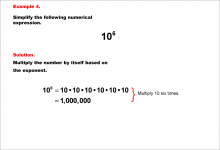
|
Math Example--Exponential Concepts--Integer and Rational Exponents--Example 4 | Math Example--Exponential Concepts--Integer and Rational Exponents--Example 4TopicExponents DescriptionShows Example 4 with the expression 106. The solution simplifies by multiplying 10 six times. Example 4: Simplify 106. Multiply 10 by itself six times: 10•10•10•10•10•10 = 1,000,000. |
Numerical Expressions |

|
Math Example--Exponential Concepts--Integer and Rational Exponents--Example 4 | Math Example--Exponential Concepts--Integer and Rational Exponents--Example 4TopicExponents DescriptionShows Example 4 with the expression 106. The solution simplifies by multiplying 10 six times. Example 4: Simplify 106. Multiply 10 by itself six times: 10•10•10•10•10•10 = 1,000,000. |
Numerical Expressions |
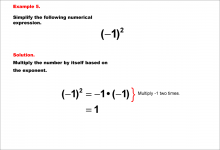
|
Math Example--Exponential Concepts--Integer and Rational Exponents--Example 5 | Math Example--Exponential Concepts--Integer and Rational Exponents--Example 5TopicExponents DescriptionShows Example 5 with the expression (-1)2. The solution explains the result by multiplying -1 by itself. Example 5: Simplify (-1)2. Multiply -1 by itself two times: (-1)•(-1) = 1. |
Numerical Expressions |

|
Math Example--Exponential Concepts--Integer and Rational Exponents--Example 5 | Math Example--Exponential Concepts--Integer and Rational Exponents--Example 5TopicExponents DescriptionShows Example 5 with the expression (-1)2. The solution explains the result by multiplying -1 by itself. Example 5: Simplify (-1)2. Multiply -1 by itself two times: (-1)•(-1) = 1. |
Numerical Expressions |
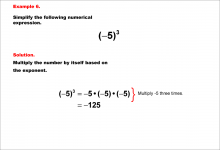
|
Math Example--Exponential Concepts--Integer and Rational Exponents--Example 6 | Math Example--Exponential Concepts--Integer and Rational Exponents--Example 6TopicExponents DescriptionShows Example 6 with the expression (-5)3. The solution demonstrates multiplying -5 three times. Example 6: Simplify (_5)3. Multiply -5 by itself three times: (-5)•(-5)•(-5) = -125. |
Numerical Expressions |

|
Math Example--Exponential Concepts--Integer and Rational Exponents--Example 6 | Math Example--Exponential Concepts--Integer and Rational Exponents--Example 6TopicExponents DescriptionShows Example 6 with the expression (-5)3. The solution demonstrates multiplying -5 three times. Example 6: Simplify (_5)3. Multiply -5 by itself three times: (-5)•(-5)•(-5) = -125. |
Numerical Expressions |

|
Math Example--Exponential Concepts--Integer and Rational Exponents--Example 7 | Math Example--Exponential Concepts--Integer and Rational Exponents--Example 7TopicExponents DescriptionShows Example 7 with the expression (-6)4. The solution explains multiplying -6 by itself four times. Example 7: Simplify (-6)4. Multiply -6 by itself four times: (-6)•(-6)•(-6)•(-6) = 1296. |
Numerical Expressions |

|
Math Example--Exponential Concepts--Integer and Rational Exponents--Example 7 | Math Example--Exponential Concepts--Integer and Rational Exponents--Example 7TopicExponents DescriptionShows Example 7 with the expression (-6)4. The solution explains multiplying -6 by itself four times. Example 7: Simplify (-6)4. Multiply -6 by itself four times: (-6)•(-6)•(-6)•(-6) = 1296. |
Numerical Expressions |
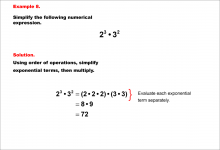
|
Math Example--Exponential Concepts--Integer and Rational Exponents--Example 8 | Math Example--Exponential Concepts--Integer and Rational Exponents--Example 8TopicExponents DescriptionShows Example 8 with the expression 23•32. The solution demonstrates using order of operations to simplify each term separately, then multiply. Example 8: Simplify 23•32. Evaluate each exponential term separately, then multiply: 8•9 = 72. |
Numerical Expressions |

|
Math Example--Exponential Concepts--Integer and Rational Exponents--Example 8 | Math Example--Exponential Concepts--Integer and Rational Exponents--Example 8TopicExponents DescriptionShows Example 8 with the expression 23•32. The solution demonstrates using order of operations to simplify each term separately, then multiply. Example 8: Simplify 23•32. Evaluate each exponential term separately, then multiply: 8•9 = 72. |
Numerical Expressions |
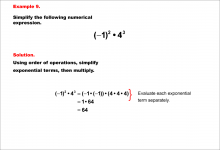
|
Math Example--Exponential Concepts--Integer and Rational Exponents--Example 9 | Math Example--Exponential Concepts--Integer and Rational Exponents--Example 9TopicExponents DescriptionShows Example 9 with the expression (-1)2•43. The solution explains simplifying each term individually before multiplying. Example 9: Simplify (-1)2•43. Evaluate each exponential term separately, then multiply: 1•64 = 64. |
Numerical Expressions |

|
Math Example--Exponential Concepts--Integer and Rational Exponents--Example 9 | Math Example--Exponential Concepts--Integer and Rational Exponents--Example 9TopicExponents DescriptionShows Example 9 with the expression (-1)2•43. The solution explains simplifying each term individually before multiplying. Example 9: Simplify (-1)2•43. Evaluate each exponential term separately, then multiply: 1•64 = 64. |
Numerical Expressions |
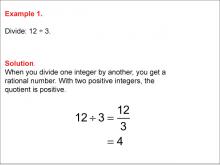
|
Math Example--Numerical Expressions--Dividing Integers: Example 1 | Math Example--Numerical Expressions--Dividing Integers: Example 1TopicNumerical Expressions DescriptionThis example demonstrates the division of two positive integers: 12 divided by 3. The solution shows that when dividing one integer by another, the result is a rational number. In this case, with two positive integers, the quotient is positive. The calculation is presented as 12 ÷ 3 = 12 / 3 = 4. |
Numerical Expressions |
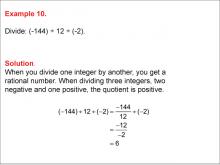
|
Math Example--Numerical Expressions--Dividing Integers: Example 10 | Math Example--Numerical Expressions--Dividing Integers: Example 10TopicNumerical Expressions DescriptionThis example demonstrates the division of three integers: (-144) ÷ 12 ÷ (-2). The solution shows that dividing three integers, two negative and one positive, results in a positive quotient. The calculation is presented step-by-step: (-144) ÷ 12 ÷ (-2) = -12 / -2 = 6. |
Numerical Expressions |

|
Math Example--Numerical Expressions--Dividing Integers: Example 11 | Math Example--Numerical Expressions--Dividing Integers: Example 11TopicNumerical Expressions DescriptionThis example demonstrates the division of three integers: (-150) ÷ (-5) ÷ 3. The solution shows that dividing three integers, two negative and one positive, results in a positive quotient. The calculation is presented step-by-step: (-150) ÷ (-5) ÷ 3 = 30 / 3 = 10. |
Numerical Expressions |